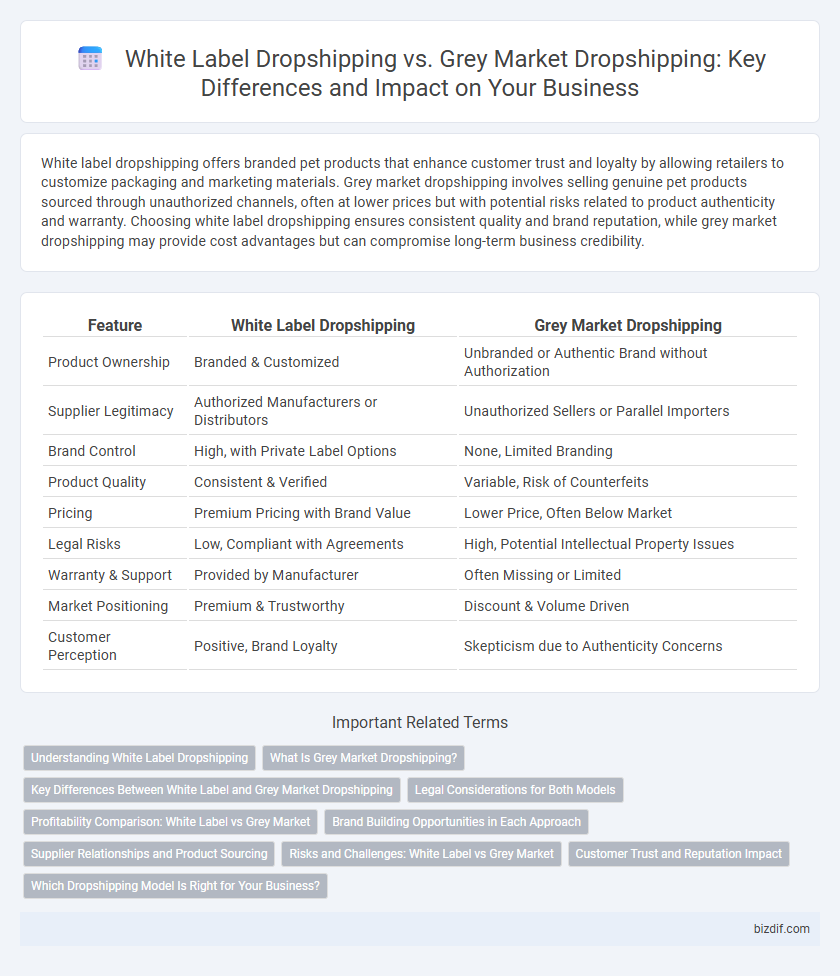White label dropshipping offers branded pet products that enhance customer trust and loyalty by allowing retailers to customize packaging and marketing materials. Grey market dropshipping involves selling genuine pet products sourced through unauthorized channels, often at lower prices but with potential risks related to product authenticity and warranty. Choosing white label dropshipping ensures consistent quality and brand reputation, while grey market dropshipping may provide cost advantages but can compromise long-term business credibility.
Table of Comparison
| Feature | White Label Dropshipping | Grey Market Dropshipping |
|---|---|---|
| Product Ownership | Branded & Customized | Unbranded or Authentic Brand without Authorization |
| Supplier Legitimacy | Authorized Manufacturers or Distributors | Unauthorized Sellers or Parallel Importers |
| Brand Control | High, with Private Label Options | None, Limited Branding |
| Product Quality | Consistent & Verified | Variable, Risk of Counterfeits |
| Pricing | Premium Pricing with Brand Value | Lower Price, Often Below Market |
| Legal Risks | Low, Compliant with Agreements | High, Potential Intellectual Property Issues |
| Warranty & Support | Provided by Manufacturer | Often Missing or Limited |
| Market Positioning | Premium & Trustworthy | Discount & Volume Driven |
| Customer Perception | Positive, Brand Loyalty | Skepticism due to Authenticity Concerns |
Understanding White Label Dropshipping
White label dropshipping involves selling products manufactured by a third party under your own brand, enabling customized packaging and consistent brand identity. This model enhances customer trust and loyalty through professional branding while simplifying inventory management since products ship directly from suppliers. Understanding white label dropshipping is essential for entrepreneurs aiming to establish a unique market presence without the need for extensive product development or warehousing.
What Is Grey Market Dropshipping?
Grey market dropshipping involves selling products sourced from unauthorized suppliers or parallel imports outside official distribution channels, often at lower prices but with risks like lack of manufacturer warranties and potential legal issues. This practice contrasts with white label dropshipping, where products are branded and sold under the retailer's own label, ensuring greater control over quality and branding. Grey market goods may attract budget-conscious consumers but carry uncertainties in authenticity and post-sale support.
Key Differences Between White Label and Grey Market Dropshipping
White label dropshipping involves selling products under a retailer's own brand with verified, authorized suppliers, ensuring quality control and consistent customer experience. Grey market dropshipping sources products from unauthorized sellers or parallel imports, often leading to uncertain product authenticity and limited after-sales support. The key differences lie in brand control, product legitimacy, and warranty reliability, impacting customer trust and business reputation.
Legal Considerations for Both Models
White label dropshipping involves selling products under your own brand, requiring strict adherence to trademark laws and supplier agreements to avoid intellectual property infringement. Grey market dropshipping deals with genuine products sold through unauthorized channels, posing risks of product authenticity issues and potential legal action from original manufacturers. Both models demand careful due diligence on contracts and regional regulations to ensure compliance and mitigate legal liabilities.
Profitability Comparison: White Label vs Grey Market
White label dropshipping offers higher profitability through brand control, premium pricing, and customer loyalty, reducing competition and enhancing margins. Grey market dropshipping often yields lower profits due to price sensitivity, unverified product quality, and potential legal risks, which can erode long-term revenue. Entrepreneurs focusing on sustainable income prefer white label models despite higher upfront investment compared to the low-cost, higher-risk grey market alternatives.
Brand Building Opportunities in Each Approach
White label dropshipping offers significant brand-building opportunities by allowing sellers to customize products and packaging, fostering customer loyalty and a distinct brand identity. In contrast, grey market dropshipping often involves selling authentic products without official authorization, limiting brand control and hindering long-term brand equity development. Prioritizing a white label strategy enables entrepreneurs to create a scalable brand presence and consistent customer experience.
Supplier Relationships and Product Sourcing
White label dropshipping involves partnering with authorized suppliers to source products that can be rebranded, ensuring consistent quality and reliable inventory management. Grey market dropshipping relies on less regulated or unauthorized suppliers, which often leads to unpredictable product authenticity and potential supply chain disruptions. Establishing strong supplier relationships in white label dropshipping enhances trust and scalability, while grey market sourcing increases risks related to product quality and customer satisfaction.
Risks and Challenges: White Label vs Grey Market
White label dropshipping offers brand control and product quality assurance but involves higher upfront costs and potential supplier dependency risks. Grey market dropshipping presents low entry barriers and competitive pricing yet carries significant challenges such as legal risks, counterfeit products, and unreliable supplier reputations. Both models demand thorough due diligence to mitigate issues like market saturation, customer trust erosion, and compliance with intellectual property laws.
Customer Trust and Reputation Impact
White label dropshipping enhances customer trust by offering branded products that appear legitimate and consistent, strengthening brand reputation and fostering long-term loyalty. In contrast, grey market dropshipping often involves selling genuine products through unauthorized channels, which can lead to warranty issues and perceived risks, damaging customer trust and brand credibility. Maintaining a transparent and authentic supply chain in white label dropshipping helps secure a positive reputation and reduces returns and complaints.
Which Dropshipping Model Is Right for Your Business?
White label dropshipping offers brand control and product quality assurance by allowing you to sell products under your own label, ideal for businesses aiming to build a unique brand identity. Grey market dropshipping involves selling genuine products sourced through unauthorized channels, often at lower costs but with higher risks related to warranty and authenticity, suitable for businesses prioritizing competitive pricing over brand exclusivity. Evaluating your business goals, target audience, and risk tolerance will help determine whether white label or grey market dropshipping aligns best with your growth strategy.
White Label Dropshipping vs Grey Market Dropshipping Infographic

 bizdif.com
bizdif.com